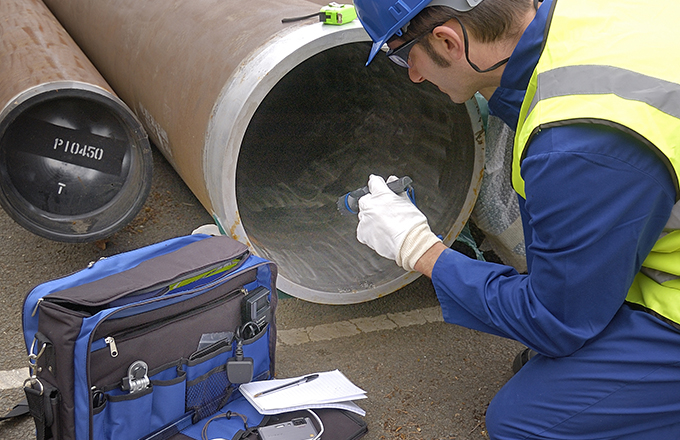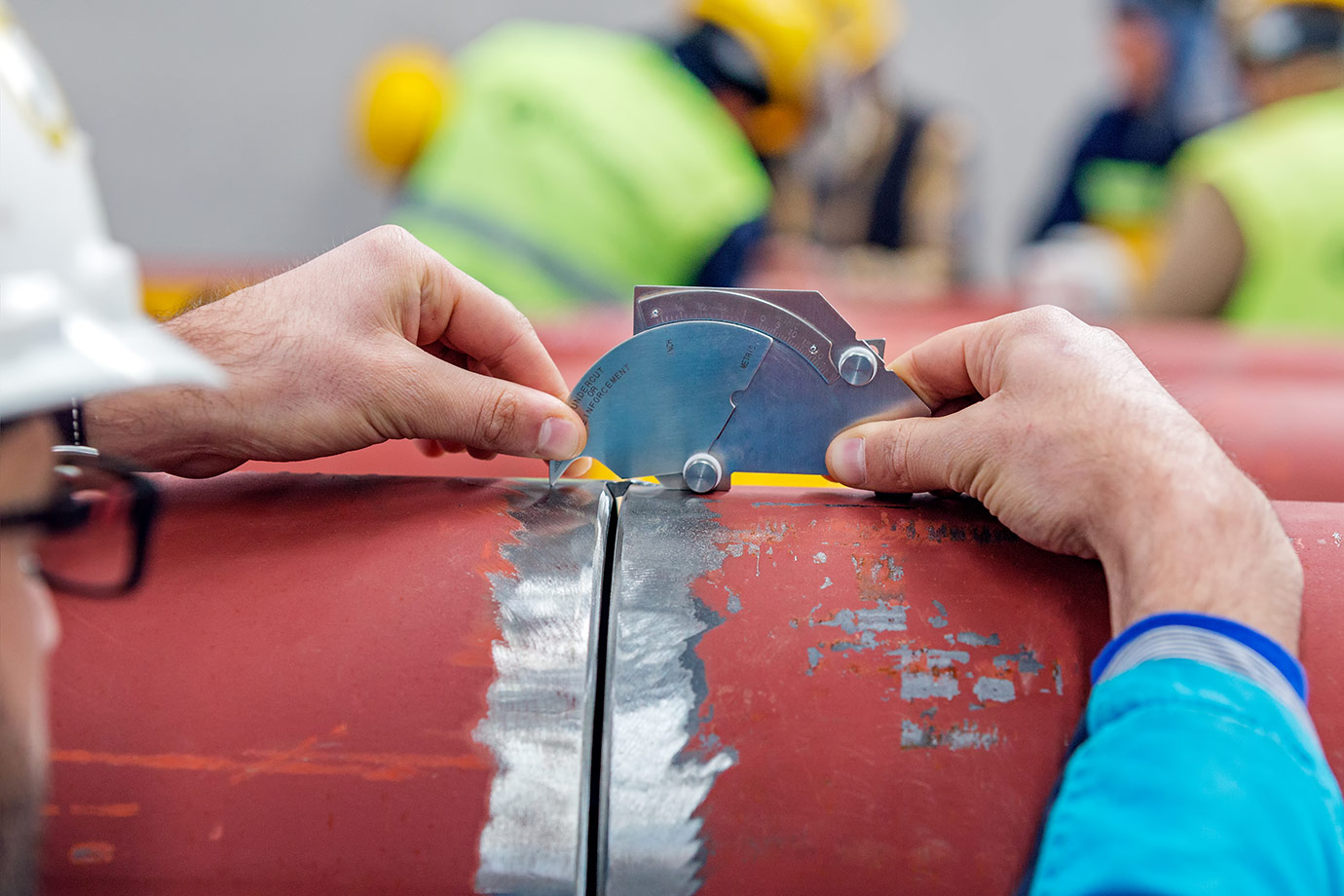Pipeline Welding Inspection: Making Sure Conformity with Market Specifications
Pipeline Welding Inspection: Making Sure Conformity with Market Specifications
Blog Article
Recognizing the Principles of Pipeline Welding Evaluation: Crucial Factors for Examining Weld High Quality and Stopping Failings
In the world of pipeline welding evaluation, the risks are undoubtedly high, demanding an extensive understanding of basic principles to guarantee weld top quality and mitigate failure dangers. Numerous crucial aspects come right into play, including the selection of appropriate products, the application of innovative inspection methods, and the acknowledgment of prevalent welding problems.
Importance of Weld High Quality
The honesty of a pipe is fundamentally dependent on the top quality of its welds, making weld top quality a crucial consider making certain safe and efficient operation. A pipeline weld serves as a junction point where materials are joined, and any deficiencies in this area can lead to significant structural weaknesses. Poor bonded top quality can cause leakages, tears, and tragic failings, posturing significant safety and security dangers and ecological risks.
Several aspects contribute to the high quality of a weld, including the choice of welding procedure, the abilities of the welder, and the problems under which the welding is carried out - Pipeline Welding Inspection. Inadequate prep work, improper heat input, and contamination can jeopardize weld stability, resulting in issues such as porosity, incomplete blend, or fractures. As a result, strict high quality control measures must be applied throughout the welding procedure to reduce these risks
In addition, the long-lasting performance of a pipe is greatly influenced by the durability of its welds. High-quality welds not just enhance the total stamina of the pipeline yet likewise extend its solution life, minimizing the need for pricey repair services and downtime. Thus, making certain superior weld top quality is critical in pipe style and maintenance methods.
Key Assessment Techniques
Making sure weld quality demands the implementation of reliable inspection methods to identify prospective flaws before they lead to failings. Pipeline Welding Inspection. Amongst the most commonly used techniques are aesthetic inspection, radiographic testing (RT), ultrasonic screening (UT), and magnetic particle testing (MT) Each strategy offers an unique function and is selected based upon the specific demands of the pipe task
Visual evaluation is the initial line of protection, allowing examiners to analyze surface area conditions, positioning, and general handiwork. It is a economical and fast method that can reveal apparent flaws. Radiographic screening gives a detailed view of internal weld integrity by utilizing X-rays or gamma rays to find subsurface flaws. This method is specifically reliable for recognizing splits, incorporations, and gaps.
Ultrasonic testing uses high-frequency acoustic waves to examine the density and stability of welds, making it perfect for identifying internal suspensions. Magnetic particle testing is a dependable approach for recognizing surface area and near-surface flaws on ferromagnetic materials by using magnetic fields and fine ferrous fragments. By making use of these essential evaluation techniques, pipe welding examiners can ensure the finest criteria are preserved, ultimately causing safer and extra trustworthy pipeline systems.
Usual Welding Problems
In the realm of pipeline welding, understanding typical welding defects is vital for maintaining architectural stability and safety and security. These problems can lead to disastrous failures otherwise identified and resolved quickly. Amongst the most prevalent issues are porosity, which occurs when gas allures in the weld steel, creating spaces that weaken the joint. One more substantial issue is absence of blend, where the weld metal does not adequately bond with the base material, endangering the joint's strength.

Cracks are likewise an essential issue, materializing in numerous kinds such as warm cracks, cold splits, and root cracks. Each type postures one-of-a-kind challenges and needs particular evaluation techniques for detection. Undercut is one more problem that can reduce the weld's cross-sectional location, leading to stress focus factors, while slag incorporation takes place when non-metallic material becomes entraped in the weld swimming pool, detrimentally influencing the mechanical buildings of the weld.
Additionally, incorrect grain form can bring about unequal tension circulation. Identifying these typical issues is vital for welders and assessors alike, as very early discovery and correction are essential to guaranteeing the durability and reliability of pipe systems.

Materials and Their Influence
Selecting the ideal materials for pipe welding substantially affects the general efficiency and integrity of the bonded joints. The choice of base steels, filler products, and finishings plays an important role in establishing the toughness, deterioration resistance, and sturdiness of the welds. For instance, carbon steel is generally used for its balance of strength and expense, yet it may be susceptible to deterioration in specific atmospheres, demanding using corrosion-resistant alloys or safety coatings.
In addition, different steel welding needs cautious consideration of thermal growth buildings and possible galvanic deterioration. The compatibility of products can considerably impact the microstructure of the weld, resulting in variations in mechanical residential or commercial properties. For example, stainless steel supplies superb rust resistance but may require specific filler products to make certain a sound weld joint.
Additionally, the influence of temperature level and environmental conditions on product choice can not be ignored. High-strength steels may shed ductility at elevated temperature levels, while low-temperature applications could need materials with boosted durability. Ultimately, recognizing the ramifications of material selections is necessary for accomplishing optimal weld top quality and stopping failures in pipe systems.

Regulative Specifications and Conformity
Governing criteria and conformity play a crucial duty in pipeline welding, developing the structure within which efficient and risk-free methods are preserved. These standards are developed by various companies, consisting of Read Full Article the American Culture of Mechanical Designers (ASME), the American Welding Society (AWS), and the Pipeline and Hazardous Materials Safety And Security Management (PHMSA) Sticking to these policies guarantees that welding procedures meet the called for top quality and security benchmarks.
Compliance with governing requirements is vital not only for ensuring the honesty of the welds however likewise for protecting the setting and public safety and security. Examiners are tasked with validating that welding procedures adhere to these standards via extensive evaluations of both the processes and the last welds. This includes evaluating welder qualifications, welding treatments, and the materials made use of.
Failure to comply with well-known guidelines can result in substantial repercussions, including pricey repair work, lawful obligations, and catastrophic failings. For that reason, companies need to integrate conformity into their functional practices, promoting a society of security and top quality. Routine training and audits are vital components in preserving adherence to these regulatory requirements, ensuring that all employees are well-informed and outfitted to copyright the greatest degrees of pipeline welding high quality.
Conclusion
In verdict, a comprehensive understanding of pipe welding inspection is essential for guaranteeing weld top quality and protecting against failings. By using essential examination methods and identifying usual welding problems, examiners can successfully assess the integrity of welds. Factor to consider of product option and adherence to regulatory criteria better improve the reliability and safety and security of pipe systems. Eventually, these techniques add to the avoidance of leaks and catastrophic failures, highlighting the vital importance of rigorous evaluation procedures in pipeline building and construction and maintenance.
In the world of pipeline welding evaluation, the risks are indisputably high, requiring a detailed understanding of essential concepts to guarantee weld top quality and alleviate failure threats (Pipeline Welding you can try these out Inspection).The integrity of a pipeline is fundamentally dependent on the high quality of its welds, making weld top quality a critical aspect in ensuring secure and efficient procedure.Numerous elements contribute to the high quality of a weld, including the selection of welding process, the news abilities of the welder, and the conditions under which the welding is done. Undercut is one more problem that can lower the weld's cross-sectional area, leading to anxiety focus points, while slag inclusion happens when non-metallic material becomes caught in the weld pool, detrimentally affecting the mechanical residential properties of the weld
In conclusion, a thorough understanding of pipe welding inspection is crucial for guaranteeing weld high quality and preventing failings.
Report this page